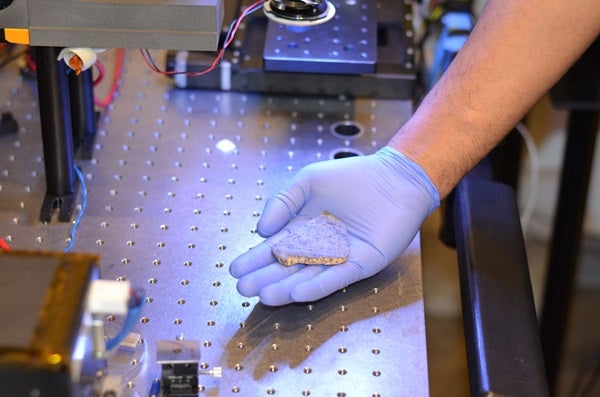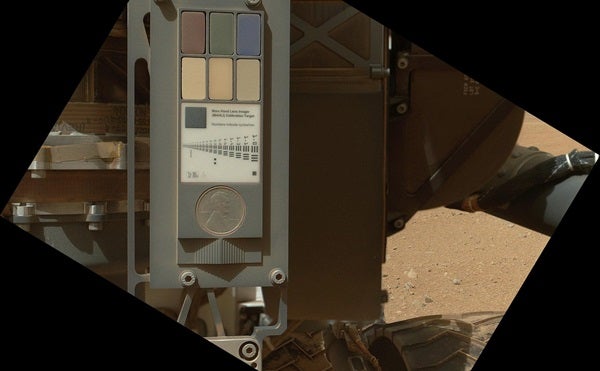The mission, currently being constructed in Pasadena, California, at NASA’s Jet Propulsion Laboratory (JPL), will use SHERLOC to study and collect samples of Mars’ surface to be brought to Earth by a later mission. The instrument is capable of detecting rock elements as fine as a strand of hair, but to ensure this level of precision, a calibration target is required.
“We’re studying things on such a fine scale that slight misalignments, caused by changes in temperature or even the rover settling into sand, can require us to correct our aim,” said JPL’s Luther Beegle, SHERLOC’s principle investigator, in a press release. “By studying how the instrument sees a fixed target, we can understand how it will see a piece of the martian surface.”
A combination of two images show the calibration targets for the Mars Hand Lens Imager, an instrument on NASA’s Curiosity rover designed to capture high-resolution images of rocks and soil on Mars. The targets include color references, a 1909 penny, a bar graphic, and a stair-step pattern.
To help select SHERLOC’S target, JPL called upon NASA’s Johnson Space Center in Houston and the Natural History Museum of London. The Meteoritical Society has only confirmed about 200 martian meteorites, and the Mars 2020 team had to make sure they chose one solid enough to withstand the mission’s launch and landing. Researchers cut off small fragments of multiple meteorites to see if they would crumble, and eventually settled on the sturdy SaU008 meteorite, which was found in Oman in 1999. SaU008 will go down as the first martian meteorite to return home to the Red Planet’s surface; NASA’s Mars Global Surveyor also contained a meteorite, which remains in orbit today.
SHERLOC will use fluorescence and Raman spectroscopies to scan Mars’ surface for specific chemical compounds, a first-of-its-kind study of the Red Planet. The laser will shine ultraviolet light over the martian surface, causing specific carbon-based chemicals to illuminate. SHERLOC will also snap photos of the rocks and record the chemicals it picks up. Researchers will use the data to see if Mars’ chemical components hint at signs of past microbial life.
In addition to searching for previous life, the rover will help determine safety conditions for future astronauts. Mars 2020 will bring spacesuit fabric, a helmet visor, and gloves to see how they hold up under Mars’ weather conditions. Studying the planet’s environment is crucial in preparing for future manned missions to Mars, and for bringing us closer to again saying, “One small step for man…”











